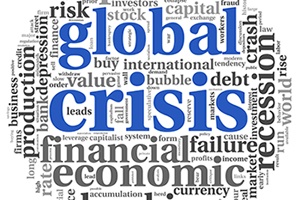 Ten years ago today, the global financial system started to crack with the decision by the French bank BNP Paribas to block withdrawals from hedge funds that invested in U.S. mortgage securities. That, as we now know, led to a widening crisis of confidence over what securities were really worth, which in turn called into question the basic solvency of many financial institutions. Unable to know who was safe—or what collateral was worth—the financial system went into gridlock, leading to the crisis we have been recovering from ever since.
Ten years ago today, the global financial system started to crack with the decision by the French bank BNP Paribas to block withdrawals from hedge funds that invested in U.S. mortgage securities. That, as we now know, led to a widening crisis of confidence over what securities were really worth, which in turn called into question the basic solvency of many financial institutions. Unable to know who was safe—or what collateral was worth—the financial system went into gridlock, leading to the crisis we have been recovering from ever since.
Of course, 10 years before that was 1997. This was not a crisis but did lead into one two years later. And 10 years before that? It was 1987, which saw the largest one-day decline in U.S. market history. We seem to have a bit of a pattern here, with problems arising roughly every 10 years.
So, what should we be thinking about?
It is typically when confidence is highest, and fear is lowest, that crisis strikes seemingly out of the blue. With consumer and business confidence high, and market complacency at record levels, investors and markets are clearly expecting the good times to continue. On that basis, now is probably a good time to worry. The question is, what can we learn from the start of the financial crisis to worry more effectively?
1) Small items can turn out to be very big. Subprime mortgages, initially thought to be a small and containable problem, turned out to be much larger and more intertwined with the financial system as a whole than had been thought. What is today’s equivalent? One real possibility is loose central bank monetary policy. As the Fed starts to pull back, and other central banks ease less, the assumption is that the global economy and markets will take this in stride. Last time, we had never had a national housing price collapse. This time, however, we have never had a global tightening cycle. Nothing is more intertwined with markets than interest rate policy—and nothing has a greater possibility of unintended side effects.
2) The effects of leverage. Leverage comes in many forms. The one particularly worth watching is margin debt against the U.S. stock market, which is at record highs as a percentage of the market’s value. Homeowners who found themselves underwater and wiped out as their home values dropped below their mortgages know exactly how risky debt can be. Investors, whose portfolios will be sold off either voluntarily or involuntarily as the market declines, could be the next to find out.
3) Interconnections that might spread risk fast. The banking system is more aware of these risks, so the crisis would likely be different this time. But the financial system will still be key. Some possibilities are the interbank lending system in Europe, where imbalances between countries remain high. Another is corporate debt worldwide, given that both interest rate spreads and restrictions on borrowers are at extremely low levels. There is a tremendous amount of debt out there—priced for perfection—and contagion could spread rapidly.
4) Illiquidity could amplify any of these problems. An absence of buyers, when sellers want or need to sell, can result in substantial price swings. While recent financial reforms have generally made the system safer, they have also reduced the ability of financial institutions to make markets and offer liquidity. This is not a problem in healthy markets, but it could be another agent of contagion when things get difficult.
What’s the takeaway?
Looking back at 2007, what’s the main takeaway here? I would suggest that while another crisis remains unlikely, many of the same risks remain real possibilities if given the right set of circumstances. For all of the current confidence, and even complacency, risks have not gone away.
With crises a regular feature of financial markets, the one thing that we should have learned from 2007—as we should have learned from 2000, 1987, and so on (and should certainly keep in mind now)—is simply this: it could happen again.


 Print
Print

